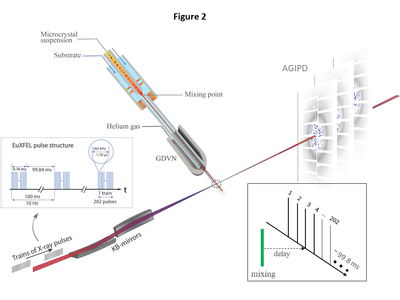Journal:IUCrJ:S2052252521008125
From Proteopedia
(Difference between revisions)

| (13 intermediate revisions not shown.) | |||
| Line 11: | Line 11: | ||
{{Clear}} | {{Clear}} | ||
| - | We follow the increase of the CEF occupancy in the catalytic cleft of BlaC from 5 ms to 50 ms after mixing with CEF by XFEL based MISC experiments. | + | We follow the increase of the CEF occupancy in the catalytic cleft of BlaC from 5 ms to 50 ms after mixing with CEF by XFEL based MISC experiments. At the edge of the crystal, almost all active BlaC subunits (B and D) are bound to CEF already at 5 ms. In the center the BlaC-CEF complex concentration is 0.21 mmol/L (2.7 % of the total concentration of B and D subunits in the crystal), although the CEF concentration delivered by diffusion is already 35 mmol/L (which is 23 % of the outside CEF concentration but 5.5 times the stoichiometric concentration). The situation changes completely at 30 ms, where almost 100 % occupancy is reached everywhere in the crystal which is in accordance with earlier results (Olmos ''et al.,'' 2018)<ref>PMID:29848358</ref>, and with the occupancy at Δtm = 50 ms reported here (see movie below) |
| + | |||
| + | <qt>file=Image:Supplementary_movie_2a.mp4|autoplay=false|width=400|height=400|controller=true|loop=false</qt><br/> | ||
| + | {{Clear}} | ||
| + | |||
| + | Steps of the CEF-BlaC binding: | ||
*<scene name='88/889829/Cv/8'>0 ms, the CEF ligand is not yet diffused in, the phosphate (Pi) from the crystallization buffer is dominant in the active site</scene>. | *<scene name='88/889829/Cv/8'>0 ms, the CEF ligand is not yet diffused in, the phosphate (Pi) from the crystallization buffer is dominant in the active site</scene>. | ||
*<scene name='88/889829/Cv/7'>5 ms, the phosphate is beginning to be displaced by CEF</scene>. | *<scene name='88/889829/Cv/7'>5 ms, the phosphate is beginning to be displaced by CEF</scene>. | ||
| Line 17: | Line 22: | ||
*<scene name='88/889829/Cv/10'>50 ms after mixing, little evidence of the phosphate | *<scene name='88/889829/Cv/10'>50 ms after mixing, little evidence of the phosphate | ||
remains</scene>. | remains</scene>. | ||
| - | *<scene name='88/889829/Cv/11'>Animation of these scenes</scene>. | ||
| - | {{Button Toggle AnimationOnPause}}<br/> | ||
| - | <qt>file=Image: | + | See also the movie below, which visualizes how the CEF interacts with the BlaC: |
| + | |||
| + | <qt>file=Image:Supplementary_movie_Polder1.mp4|autoplay=false|width=400|height=400|controller=true|loop=false</qt><br/> | ||
| + | {{Clear}} | ||
From the increasing occupancy values we are able to estimate an effective diffusion coefficient Deff of CEF in the BlaC microcrystals. Diffusion is roughly an order of magnitude slower in the crystals than that in water. By using the Deff we are now able to calculate CEF occupancies anywhere in the microcrystals and at any time. Since the BlaC-CEF complex formation triggers the enzymatic cycle, the speed of its formation determines the time-resolution of the MISC method. Our results show that the time-resolution is on the order of 5 ms for our microcrystals. The structures of any intermediates whose lifetimes are longer can therefore be characterized. Once faster intermediates are concerned, smaller crystals must be used that support a faster buildup of the enzyme substrate complex. | From the increasing occupancy values we are able to estimate an effective diffusion coefficient Deff of CEF in the BlaC microcrystals. Diffusion is roughly an order of magnitude slower in the crystals than that in water. By using the Deff we are now able to calculate CEF occupancies anywhere in the microcrystals and at any time. Since the BlaC-CEF complex formation triggers the enzymatic cycle, the speed of its formation determines the time-resolution of the MISC method. Our results show that the time-resolution is on the order of 5 ms for our microcrystals. The structures of any intermediates whose lifetimes are longer can therefore be characterized. Once faster intermediates are concerned, smaller crystals must be used that support a faster buildup of the enzyme substrate complex. | ||
| - | In addition to the CEF binding we observe the reaction of BlaC with an inhibitor sulbactam (SUB) at 66 ms. SUB reacts to a so-called trans enamine in subunits B and D of the BlaC already after 66 ms. However, SUB stays intact in subunits A and C. As the reaction proceeds to the trans-enamine also in A and C, the structures of the weakly bound SUBs in these subunits at 66 ms represent an interesting intermediate that would not have been detected in static structures. | + | In addition to the CEF binding we observe the reaction of <scene name='88/889829/Cv/14'>BlaC with an inhibitor sulbactam</scene> (SUB) at 66 ms. SUB reacts to a so-called <scene name='88/889829/Cv/15'>trans-enamine in subunits B and D of the BlaC</scene> already after 66 ms. However, <scene name='88/889829/Cv/14'>SUB stays intact in subunits A and C</scene>. As the reaction proceeds to the ''trans''-enamine also in A and C, the structures of the weakly bound SUBs in these subunits at 66 ms represent an interesting intermediate that would not have been detected in static structures. |
| + | {{Clear}} | ||
| + | '''PDB references:''' BlaC, unmixed, [[7k8l]]; mixed with ceftriaxone, 5 ms, [[7k8e]]; 10 ms, [[7k8f]]; 50 ms, [[7k8h]]; mixed with sulbactam, 66 ms, [[7k8k]]. | ||
<b>References</b><br> | <b>References</b><br> | ||
Current revision
| |||||||||||
This page complements a publication in scientific journals and is one of the Proteopedia's Interactive 3D Complement pages. For aditional details please see I3DC.

